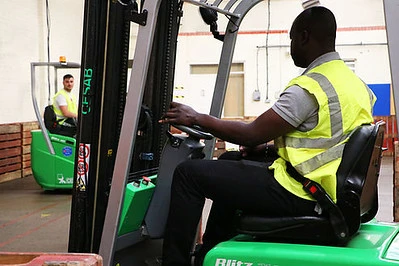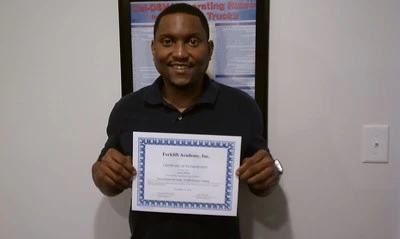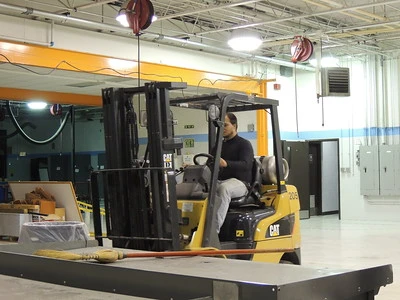Does OSHA Recognize Online Forklift Training?
January 23, 2024 | by Mike Pattenson


Yes, OSHA (Occupational Safety and Health Administration) does recognize online training for forklift operations. However, it’s important to note that online training alone is not enough. OSHA requires that forklift operators also have hands-on training and a skills evaluation. This means that after completing an online course, you would still need practical training and to be evaluated by a qualified trainer to be fully certified.
The online component of forklift training typically covers theoretical aspects, such as safety rules, regulations, and the basics of operating a forklift. This is useful for understanding the principles and safety guidelines. However, because operating a forklift involves physical skills, it’s necessary to practice with the actual equipment.
After you finish the online course, the next step is practical training. This is where you get to operate a forklift under the supervision of a trained professional. They will show you how to handle the forklift, maneuver it, and work in different conditions. This part of the training is crucial because it gives you real-world experience.
Finally, there’s a skills evaluation. An evaluator will watch you operate a forklift to make sure you can do it safely and effectively. They’ll check if you’re following the safety rules and handling the forklift correctly. Passing this evaluation is essential to be considered fully trained and compliant with OSHA’s requirements.
So, while online training is a recognized and important part of learning to operate a forklift, it’s just one part of a larger training process that includes hands-on experience and skills assessment.
OSHA’s Position on Online Training
OSHA recognizes online training as a good starting point for learning how to operate a forklift. This type of training is useful for understanding the basic rules and safety procedures. However, OSHA strongly emphasizes that online training alone is not enough. They require that anyone learning to drive a forklift must also have hands-on, practical training.
According to this specific rule:
1910.178(l)(2)(ii)
1910.178 – Powered Industrial Truck
Training shall consist of a combination of formal instruction (e.g., lecture, discussion, interactive computer learning, video tape, written material), practical training (demonstrations performed by the trainer and practical exercises performed by the trainee), and evaluation of the operator’s performance in the workplace.
OSHA’s stance on online forklift training recognizes the value of digital learning as part of the certification process but with clear conditions and limitations to ensure comprehensive operator competence and safety.
OSHA’s Position:
OSHA accepts online or computer-based training as a component of an effective forklift training program. However, it emphasizes that online training alone is not sufficient to certify an operator. The reason is simple: operating a forklift safely requires practical skills that can only be acquired through hands-on experience. Therefore, OSHA mandates that forklift training programs include three essential elements:
- Formal Instruction: This can be achieved through online courses, videos, or written materials that cover the basics of forklift operation, safety practices, and workplace-specific risks.
- Practical Training: Operators must receive hands-on training under the direct supervision of a qualified trainer. This training should cover the actual operation of a forklift, including vehicle inspection, maneuvering, and handling loads.
- Evaluation: After completing the formal instruction and practical training, operators must be evaluated in the workplace by a qualified trainer to ensure they can operate a forklift safely in their specific work environment.
Conditions and Limitations:
- Supplementary Hands-On Training: Online training must be supplemented with practical, hands-on experience. OSHA specifies that operators must demonstrate proficiency in operating the forklift and apply the safety principles learned online in a real-world setting.
- Workplace-Specific Training: Training must be relevant to the conditions and challenges of the specific workplace where the forklift will be used. This includes understanding site-specific hazards and operational procedures.
- Evaluation in Real Work Conditions: The final step of the certification process involves evaluating the operator’s ability to safely operate a forklift within their actual work environment. This ensures that the operator can apply what they’ve learned in a practical, on-the-job context.
While OSHA recognizes the role of online training in providing the theoretical foundation for safe forklift operation, it stresses the importance of complementing this training with hands-on practice and evaluation. The aim is to ensure that forklift operators are not only knowledgeable about safety practices but are also skilled in applying these practices in the daily operation of a forklift.
How Employers and Operators Can Ensure Compliance
For Employers:
- Mix It Up: Start with online training for your team. It’s like the classroom part of learning to drive. Then, make sure they get time behind the wheel of a forklift, under the guidance of someone experienced. This is where they really learn how to do the job safely.
- Check the Skills: After the online courses and practice, watch your employees work with the forklift in the real work area. It’s like a final test to make sure they can handle the machine safely in the places they’ll actually be using it.
- Keep Records: Write down who took the training, how they did with the hands-on part, and the final check of their skills. This isn’t just good for keeping track; it’s what OSHA wants to see.
For Operators:
- Pick Wisely: Look for online forklift training that covers all the basics but also says it meets OSHA’s rules. Think of it as finding a driving school that the DMV approves.
- Ask About Hands-On: Make sure there’s a plan for getting on a forklift and practicing what you’ve learned online. You wouldn’t want to learn to drive a car without ever sitting in the driver’s seat, right?
- Get Proof: Once you’ve done the online part, the hands-on training, and passed your workplace test, make sure you get some sort of certificate or record. It’s like your driver’s license for forklifts, showing you’ve done the work and know how to be safe.
Following these steps can help make sure that the training sticks, you or your team are safe on the job, and you’re all following the rules OSHA has laid out.
The Need for Hands-On Training
Hands-on training is super important when learning to drive a forklift. Here’s why:
- Real Practice: Just like you can’t learn to ride a bike by only reading a book, it is actually not as hard as you think it is, you can’t learn to drive a forklift without actually driving one. Hands-on training gives you the chance to sit in the driver’s seat, use the controls, and get a real feel for how the forklift operates. This experience is crucial because it helps you understand not just the theory, but also the practical aspects of operating a forklift.
- Feeling the Machine: Each forklift can feel different to drive. Some might be heavier, others are more sensitive in their controls. When you train hands-on, you get to experience these differences firsthand. You learn how to adjust your driving based on the specific forklift you’re using, which is a skill you can’t develop just by learning online or in a classroom.
- Dealing with Real Situations: In a real work environment, things are often unpredictable. There might be sudden obstacles, tight corners, or busy areas where you need to be extra careful. Hands-on training prepares you for these real-life scenarios. You learn how to navigate the forklift in tight spaces, how to react if something suddenly comes in your path, and how to operate safely around other people and equipment.
- Safety Skills: Operating a forklift safely is crucial, as mistakes can lead to serious accidents. Through hands-on training, you learn essential safety practices like how to properly load and unload materials, how to maintain balance and stability, and how to drive in areas crowded with people or other equipment. You also get trained on emergency procedures, which can be lifesaving in unexpected situations.
- Building Confidence: Confidence comes with practice. The more time you spend driving a forklift during hands-on training, the more comfortable and confident you become in your abilities. This confidence is important because a confident forklift operator is more likely to stay calm, make good decisions, and operate the forklift safely and efficiently. This is something that theoretical knowledge alone cannot provide.
Hands-on training in forklift operation is not just about learning the controls; it’s about understanding the vehicle, adapting to different scenarios, prioritizing safety, and building the confidence needed to operate effectively in a real-world environment.
If Hands-On is Required by OSHA, Where Can You Take This
If you need hands-on forklift training to meet OSHA’s requirements, there are several places where you can take this training:
- Local Community Colleges or Technical Schools: Many of these institutions offer forklift training programs. They usually combine classroom instruction with practical, hands-on experience.
- Vocational Training Centers: Specialized vocational training centers often provide comprehensive forklift training, including both the theoretical and practical aspects required by OSHA.
- Private Safety Training Companies: There are companies that specialize in safety training, including forklift operations. They typically offer courses that are specifically designed to meet OSHA’s standards.
- Industry Associations: Some industry associations related to warehousing, logistics, and construction offer forklift training for their members, sometimes at a discounted rate.
- On-Site Training at Your Workplace: Some employers provide on-site forklift training, especially if they have a large number of employees who need to be trained. This training is usually tailored to the specific types of forklifts and conditions in that workplace.
- Online Directories and Local Listings: You can also search online directories or local business listings for forklift training providers in your area. Websites like OSHA’s own site may have resources or directories to help you find a training provider.
Remember, when choosing a training program, it’s important to ensure that the program is comprehensive and complies with OSHA’s standards. This means the training should cover both theoretical knowledge and practical skills, along with an evaluation of your ability to safely operate a forklift.
The Online Method Is a Great Way to Comply With the Theoretical Part of the Course
Yes, the online method is a great way to comply with the theoretical part of forklift training. Here’s why:
- Convenience: Online training lets you learn from anywhere. You can do it at home, at work, or even on the go. It’s flexible, so you can fit it into your schedule.
- Accessible Information: The courses usually have videos, diagrams, and written materials. This makes it easy to understand the rules and safety procedures.
- Self-Paced Learning: With online training, you can learn at your own pace. If you need more time on a topic, you can take it. Or, if you understand something quickly, you can move on faster.
- Up-to-Date Content: Online courses are often updated with the latest safety guidelines and regulations. This means you’re learning the most current information.
- Cost-Effective: Generally, online training is less expensive than in-person training. This can be a big advantage if you’re paying for the training yourself.
So, while online training covers the book-learning part of forklift training, remember it’s just one part of the whole process. You still need hands-on practice to become a skilled and safe forklift operator, as required by OSHA.
Conclusion
To sum it up, yes, OSHA does say that online training for forklifts is okay. It’s a good way to learn the basic rules and how to be safe while driving a forklift. But, it’s just the start. OSHA also says you need to practice driving a forklift for real, with someone who knows how to teach it. This way, you learn how to actually use a forklift safely at work. So, online training is helpful, but you also need hands-on training to be fully ready to drive a forklift.
After finishing the online part, you must get real experience with a forklift. This means driving and handling it under the watch of a trained teacher. This part is super important. It’s where you really learn to drive the forklift and deal with things you might face at work, like moving heavy loads or driving in tight spaces.
OSHA wants to make sure you’re not just good at the book stuff, but also really know how to drive safely. That’s why, to be fully trained and ready according to OSHA, you need both online learning and hands-on practice. Only then are you all set to drive a forklift at your job.
RELATED POSTS
View all



